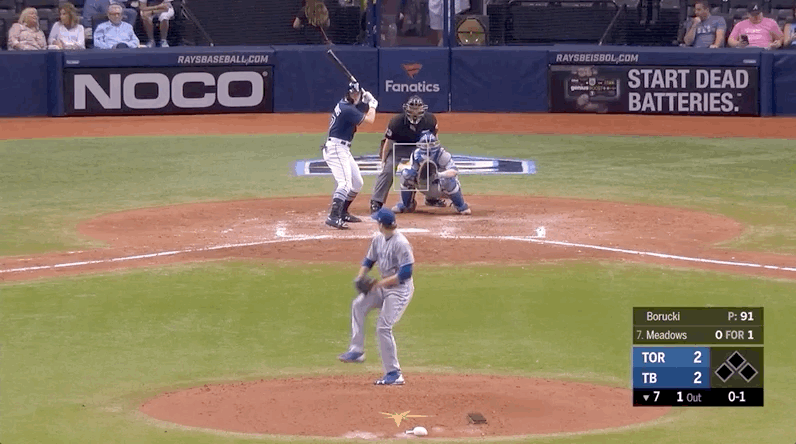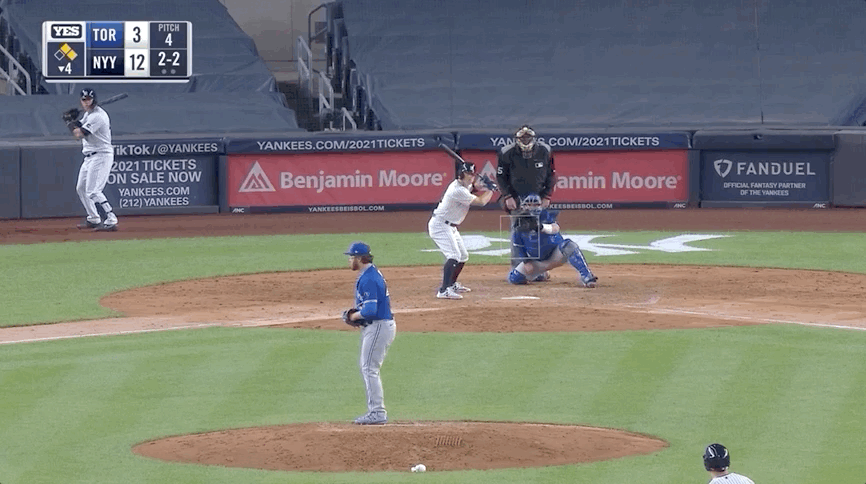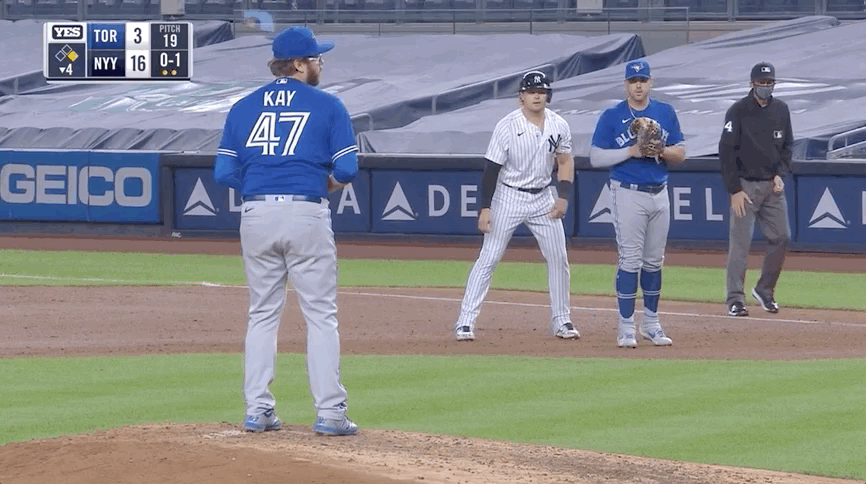You shouldn’t draw any conclusions from spring training results in a typical year. But in a pandemic year featuring games with indeterminate lengths, rolling innings, and fluid substitutions that more closely resemble controlled scrimmages? You can throw the outcomes right out the window.
It’s all about process. Who’s hitting the ball hard? Which pitchers are flashing increased velocity? What players are getting defensive reps at unfamiliar positions? Those are the important things to pay attention to. And, as always, the guys working on stuff.
Hitters tinkering with batting stance adjustments, as 2020 No. 5 overall pick Austin Martin is.
Converted starters trying new approaches as they transition to relief roles. And pitchers, in general, developing new pitches they may or may not feature in their arsenals come opening day.
The Blue Jays have a bunch of those, as the coaching tandem of Pete Walker and Matt Buschmann challenge Toronto’s young staff to not let the development process halt just because they’ve made it to the majors. “Get better every day” is splashed all over the walls of the new player development complex where Blue Jays players are training this month. And several of them are taking it to heart.
So, let’s take a closer look at three arms in Blue Jays camp toying with new weapons and assess the impact those evolutions could make.
Thomas Hatch’s curveball
Growing up, Thomas Hatch always thought he threw a curveball. It wasn’t until he reached college and pro ball that he realized how wrong he was.
“It was really a slider,” he says. “You just don’t know the difference back then. Now, we have all this technology to show us the difference right out of the hand in a bullpen. That showed me it never was a curveball.”
Whatever it was, it got outs, as Hatch spun a fantastic junior season at Oklahoma State in 2017 before quickly climbing the professional ranks and, after a trade to the Blue Jays, made his big-league debut in 2020. There, he was a revelation pitching out of Toronto’s bullpen, using his high-spin fastball and adjustable slider to pitch to a 2.73 ERA across 26.1 innings.
“His stuff, as we've seen, is outstanding as a major-league starter in the making," Walker says. "His mound presence and his arsenal are major-league calibre. I'm really excited about this guy.”
With that all behind him, Hatch figures it's finally time to learn that curveball. The Chicago Cubs were urging him to develop one prior to trading him in 2019, and it seems they were onto something as the Blue Jays came to Hatch this off-season offering the same suggestion.
It makes sense. If Hatch can replicate the extreme spin he produces with his fastball — the 2,598-RPM average on his heater last season was fifth-highest in MLB — on a curveball, odds are he can turn it into a fairly wicked offering that could miss bats at a high rate.
It’s no coincidence that some of the game’s best curveball spinners, such as Lucas Sims, Ryan Pressly, Dustin May, Tyler Glasnow, and Trevor Bauer, finished the season with curveball whiff rates of 39 per cent or higher — a top-30 mark across MLB. And all five of those pitchers were 90th percentile or higher fastball spinners, too.
Of course, that group is a high bar to reach for. Particularly for a guy who’s only recently come to understand exactly what a curveball is. But there’s no harm in trying to develop one — and the possible upside is huge. Hatch has already proven his fastball-slider-changeup mix plays well at the big-league level. If he can round that arsenal out with a curveball that generates swing-and-miss at an above-average level? Look out.
“Spring training is the time that we can get into those kinds of things and get reactions from hitters without worrying about results,” Hatch says “It’s a good opportunity to feel it out and get reactions from guys that can tell you what it looks like or what they saw.
“So, it's really about learning. It's a different pitch for me. Because the slider's kind of a power pitch. Whereas the curveball's kind of a finesse pitch. So, it's a new world to me in a way. But we're exploring that and trying to get as far as we can with it this spring.”
Ryan Borucki’s changeup
OK, so this one isn’t actually a new pitch. Back in 2018, when Ryan Borucki made his big-league debut as a starter, he threw plenty of changeups. Playing it off a then 91-92 m.p.h. sinker he used nearly 60 per cent of the time, Borucki dotted them down-and-away from right-handed hitters, earning an impressive 35.1 per cent whiff rate.
But when he was moved to the bullpen in 2020, increasing his fastball velocity to the mid-90’s in shorter stints, Borucki mostly shelved the pitch in favour of a sometimes cutter, sometimes slider — “it has a mind of its own,” he says — that better suited his new role. He still had the changeup in his back pocket, sprinkling it in every now and then to right-handers. But truth be told, he seldom needed it.
Borucki allowed only two hits — both singles — on the 122 cutter-sliders he threw last season, producing a stellar .091 wOBA and ridiculous 49.2 per cent whiff rate with the pitch. Suddenly, he was Andrew Miller Lite. But this season, Borucki’s planning to bring the changeup back.
“I'm definitely going to take a different approach. I’m going to be using all three of my pitches — no matter what kind of batter,” he says. “That's going to be a new thing for me. But I'm really confident with how it's feeling right now.”
What’s really interesting about that is Borucki’s intending to throw his changeup to both sides of the platoon. Even when it was his go-to secondary offering in 2018, he only threw it a dozen times to a left-handed hitter. The other 357 he threw that season were to right-handers.
For Borucki, the changeup to a left-hander was often a break-glass-in-case-of-emergency pitch. Of the 12 he threw, four came on the fifth pitch of the plate appearance or later as he searched for something novel to throw deep in a tough battle. He never started a plate appearance with one and only twice used it when behind in the count.
The left-on-left changeup is just a dangerous proposition. If he can set it up well and land it at the bottom of the zone towards either edge of the plate, it can be an effective tool. But if he misses and leaves it up, he risks letting it sit right in a left-handed hitter’s happy zone, which can produce unfortunate results such as this Austin Meadows bomb:

But that’s big-league baseball — execution is everything. And if Borucki can hit the catcher’s mitt with his left-on-left changeup, the pitch can be a tricky one to handle, like this one on the inner half that Jake Bauers whiffed on:

Or this excellent one down and away to Meadows in a 2-2 count that the Rays outfielder somehow didn’t offer at:

“[Walker and Buschmann] have really challenged me to try to throw that pitch to lefties because it still can be successful,” Borucki says. “Just kind of switch [the hitter] up and get them off my fastball and my slider.”
Borucki’s been testing it out against left-handers in live batting practice sessions this spring and says it’s felt good so far. Ultimately, how much he uses it will come down to how confident he is in commanding it once real games begin in April. But if he can prove to left-handed hitters that he can locate them where he wants, more changeups can only increase the effectiveness of his fastball and cutter-slider as hitters try to guard against three pitches rather than only two. And we’ve already seen how effective those first two can be.
Anthony Kay’s cutter
Funny enough, it was watching the success Borucki had with his cutter-slider that inspired Anthony Kay to try one of his own.
Predominantly a fastball-changeup pitcher in college, Kay developed a big, breaking curveball with above-average spin as a professional to round out his arsenal and earn his major-league debut after being traded to the Blue Jays in 2019. But there he found big-leaguers were squaring up his high-spin fastball more often than minor-leaguers did, which got him thinking he needed an additional firm offering with some action that could move the ball off the barrel.
So, he asked Borucki how he threw his cutter, and started toying around with some different grips. He sought feedback from Buschmann; he began throwing it while playing catch; eventually, he started using it in bullpens, continuing to tweak the grip in search of a consistent way to create the action he wanted to see. It was still very much a work in progress as the 2020 season wound down. Kay figured he’d wait until the following year to try it out in a game.
But then Alejandro Kirk happened. What the cannonball catcher lacks in professional experience, he makes up for in moxie; which is why, after Kay mentioned to him off-hand that he was working on a new cutter, Kirk suddenly called for the pitch in a live game against the New York Yankees without warning. Mopping up in the middle of a blowout, Kay figured, what the hell — I’ll go with it.
Here’s the first one he threw:

Strike three. You can see the surprise in Brett Gardner’s reaction. Tough for a hitter to be prepared for a pitch when the pitcher’s never thrown it in a game before.
The first one was so effective that Kirk went immediately back to it, calling for Kay to start the next batter, Gary Sanchez, with another cutter down and away. Again, Kay trusted the young catcher:

And there’s the danger. Kay didn’t locate that cutter as well as the one to Gardner, leaving it up and over the plate to a powerful right-handed bat. Sanchez just missed it (he’d go on to homer off a fastball two pitches later) which demonstrates the importance of landing the pitch towards the edges of the strike zone, particularly against right-handed hitters.
Still, Kay continued to spin some really nice cutters in that outing, including this one for a punch-out of Tyler Wade:

And this one he snuck past Aaron Hicks up and in:

That’s a perfect spot for the pitch against a right-handed hitter, because it ought to be a called strike if it’s taken, and it’ll be extremely difficult to get the barrel of the bat to if it’s offered at. That glove-side edge is also where Kay can use it best against left-handers, picking the corner for strikes or sweeping it outside the zone to generate whiffs. And if he can demonstrate an ability to locate the pitch arm-side, as well, he could turn it into an extremely useful weapon against both sides of the platoon.
“That was definitely one of the main focal points of the off-season this year — getting a good feel for that and working on that,” Kay says. “It's a pretty good pitch. I want it to move pretty late — hopefully, keep them off the fastball a little bit and keep the cutter off the barrel.”
Kay started his off-season program earlier this winter, throwing more bullpens than he has in the past so he could enter camp as prepared as possible. That opens up time to focus less on pure volume and stretching out his arm, and more on developing new weapons like that cutter. He’s already had some success with it in his first outing this spring. And don’t be surprised to see it on a major-league mound early this season.
Kay began 55 per cent of his plate appearances last season with a ball, which is no way to have success at the big-league level. A focus this season — as it is for all pitchers on a Blue Jays staff that posted MLB’s second-highest walk rate in 2020 — is working ahead more often. Having an additional higher velocity offering he can reliably locate for strikes can’t hurt. As with all the Blue Jays arms working to learn new pitches this spring, the pursuit of improvement never ends.
“The guys have been great so far. We've had some really good discussions. The veteran guys we brought in — Robbie Ray’s been great, Kirby Yates has been awesome. After one of our pitchers’ meetings we had for half an hour, he was still there talking shop with some of the guys and our coaching staff. I love that,” Walker says. “When you have guys that care about not only themselves and performing, but they're concerned about their teammates and trying to help guys out and help guys get better — that's what it's all about.”
